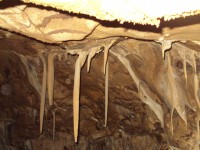Bears’ Cave
The Bears’ cave is located in the Vayotz dzor Marz (region) of the RA, 8 km south-west from the river of Arpi, in the barely passable rocks in front of the village, which are possible to overcome through the narrow and difficult mountain pathways. The cave is the longest karstic cave in the RA and generally in Transcaucasus. The height of the cave is 1655 m. The Bear cave was discovered in 1981 by the hunters and was named so because of the discovered bears' bones there. The entrance area of the cave is approximately 10 square meters. It has not been seriously subjected to geological studies after it had been discovered. The geographical location of the cave has dry continental climate with high fluctuations of temperature. Average annual precipitation is 500 mm. According to meteorological studies the average temperature in the cave is 10.2 C, the highest was 12.2 C, and the lowest 7 C. The total length of the cave is 3.5 km, deepens to the bowels of the earth more than 700 m. It is almost entirely formed of calcium carbonate and as a result, numerous and various stalactites and stalagmites were emerged there. There are huge halls inside the cave, which are connected by rather narrow corridors, pass through which is sometimes possible only when you crawl. Today it is possible to visit the cave only with special permission and accompanied by an escort. It is not recommended to enter the cave without a well-informed escort, as the probability to get lost is quite big. Supplies of water in the cave can be filled from the crystal clear waters of the cave’s river. This river was the source to the underground pond deep in the cave formed by drop by drop licking.

















